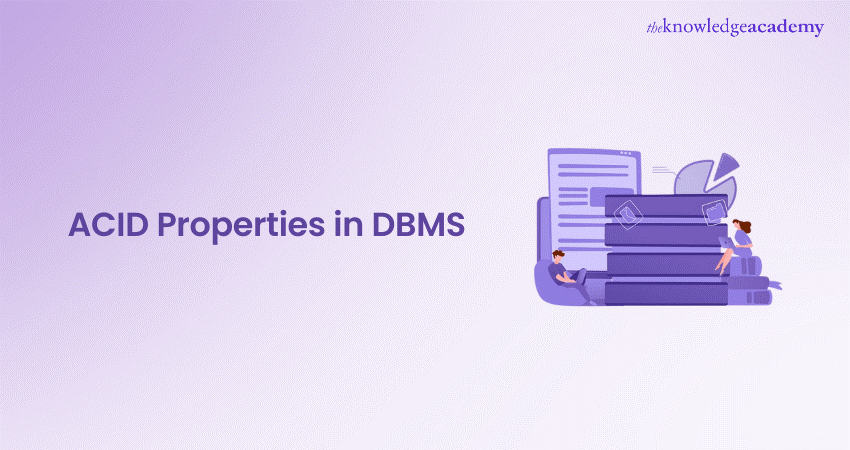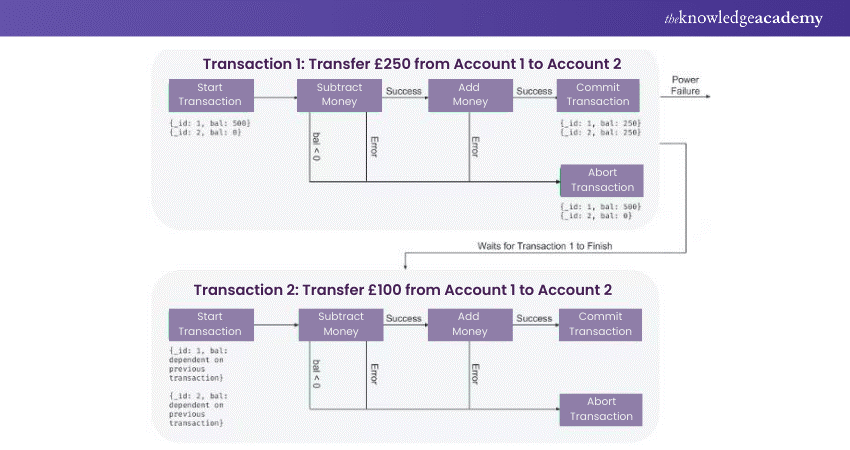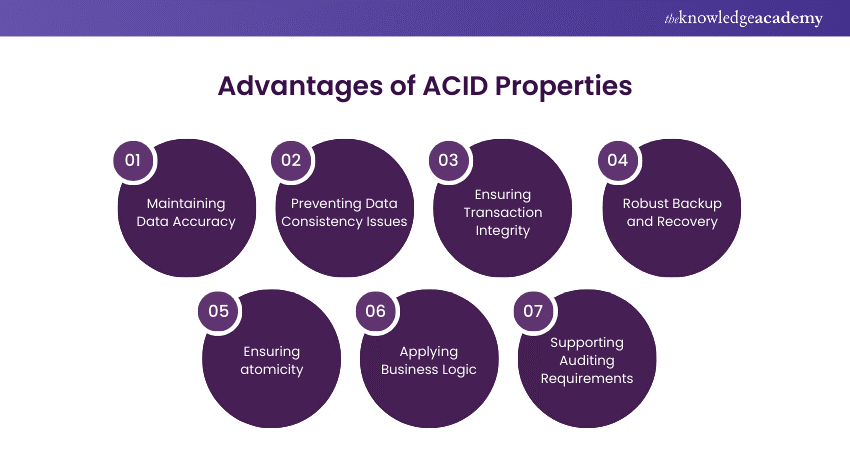We may not have the course you’re looking for. If you enquire or give us a call on +43 720 115337 and speak to our training experts, we may still be able to help with your training requirements.
Training Outcomes Within Your Budget!
We ensure quality, budget-alignment, and timely delivery by our expert instructors.

Have you ever wondered how databases maintain consistency even during system failures or concurrent transactions? The answer lies in understanding the ACID Properties in DBMS. These fundamental principles—Atomicity, Consistency, Isolation, and Durability (ACID)—act as the foundation of reliable database transactions. But what exactly do these properties entail, and why are they so crucial for modern databases?
In this blog, we will explore the ACID Properties in DBMS in detail and highlight how they ensure the robustness of Data Management Systems. Read ahead to uncover the essentials of ACID properties!
Table of Contents
1) What are ACID Properties in DBMS?
2) Example of ACID Properties in DBMS
3) Advantages of ACID Properties in DBMS
4) Disadvantages of ACID Properties in DBMS
5) Conclusion
What are ACID Properties in DBMS?
ACID properties encompass four fundamental principles: Atomicity, Consistency, Isolation, and Durability. These principles serve as checks and balances for database transactions, ensuring accuracy and reliability. Let’s explore them in detail:
1) Atomicity
Atomicity requires that transactions be treated as a single “unit of work.” The entire sequence of operations within a transaction must either succeed or fail as one entity, with no partial success or failure. For example, transferring money between bank accounts involves debiting one account and crediting another.
If either operation fails, the entire transaction is rolled back, preventing partial or incomplete transactions and maintaining data consistency.
2) Consistency
Consistency ensures that only valid data is written to the database. Before committing a transaction, consistency checks are performed to maintain database constraints and business rules. For instance, a transaction that credits an account beyond its overdraft limit is invalid and will be blocked, preventing data corruption and ensuring data accuracy.
3) Isolation
Isolation maintains the independence of database transactions. Uncommitted transactions are isolated using locking mechanisms to prevent dirty reads or lost updates. For example, if Transaction T1 updates a row, Transaction T2 must wait until T1 commits or rolls back, ensuring that T2 does not read unreliable data.
4) Durability
Durability ensures that when a transaction is committed, it remains intact and unaffected, even if a system failure occurs. This is achieved through database backups, transaction logs, and disk storage. For example, if a transaction updates a customer’s address, durability ensures the change is not lost due to hardware failure or power outage.
These ACID properties are essential for maintaining the reliability, integrity, and consistency of databases, making them crucial for any robust Database Management Systems (DBMS).
Example of ACID Properties in DBMS
To better understand how ACID properties function in real-world scenarios, let’s consider a practical example. This will illustrate how these principles ensure data integrity and reliability during database transactions.
Example- Imagine you’re developing a function to transfer money between two bank accounts, each represented as a separate record. If the money is successfully debited from the source account but not credited to the destination account, it creates a significant accounting problem. Similarly, if the destination account is credited but the source account is not debited, another serious accounting issue arises.

Both write operations must either succeed together or fail together to maintain system and data consistency. If any command within the transaction fails, the database must roll back (i.e., undo) all changes made during the transaction.
|
‘await session.withTransaction(async () => { const subtractMoneyResults = await accountsCollection.updateOne( { _id: account1 }, { $inc: { balance: amount * -1 } }, { session }); if (subtractMoneyResults.modifiedCount !== 1) { await session.abortTransaction(); return; } const addMoneyResults = await accountsCollection.updateOne( { _id: account2 }, { $inc: { balance: amount } }, { session }); if (addMoneyResults.modifiedCount !== 1) { await session.abortTransaction(); return; } });’ |
Advantages of ACID Properties
ACID properties provide transactional reliability despite failures, concurrency, and human errors. Their key uses include:

a) Maintaining Data Accuracy: Ensuring that all data entered into the database adheres to predefined rules and constraints, such as primary keys, foreign keys, and unique constraints, to maintain data accuracy and reliability.
b) Preventing Data Consistency Issues: Implementing mechanisms to avoid issues like dirty reads (reading uncommitted data), non-repeatable reads (data changes between reads within the same transaction), and phantom reads (new data appearing in subsequent reads within the same transaction), thereby ensuring data consistency during concurrent transactions.
c) Ensuring Transaction Integrity: Using transaction management techniques to ensure that all operations within a transaction are completed successfully before committing the changes, thus maintaining the database’s integrity and consistency.
d) Robust Backup and Recovery: Establishing robust backup and recovery procedures to restore the database to a consistent state after unexpected system crashes or failures, minimising data loss and downtime.
e) Ensuring atomicity: Ensuring atomicity in transactions guarantees that all operations within a transaction are fully completed or not executed at all, thereby preventing partial updates that could result in data corruption.
f) Applying Business Logic: Applying business logic and relational constraints to ensure that data adheres to the organisation’s rules and relationships, such as ensuring that orders cannot be placed for non-existent products.
g) Supporting Auditing Requirements: Implementing features that track and log database activities to support auditing requirements and ensure Compliance Risk with regulatory standards, providing transparency and accountability in Data Management.
Join our Introduction to Database Training and build a solid understanding of Database concepts – secure your spot now!
Disadvantages of ACID Properties in DBMS
While ACID properties provide numerous benefits for maintaining database integrity and reliability, they also come with certain drawbacks. Let's explore them in detail:
a) Performance Overhead: It can impact system performance due to additional processing and resource utilisation.
b) Complexity: Adds complexity to database systems, increasing design and maintenance challenges.
c) Scalability Challenges: Can pose difficulties in highly distributed or scalable systems, limiting scalability.
d) Potential for Deadlocks: Using locking mechanisms can lead to deadlocks and system halts.
e) Limited Concurrency: This may restrict concurrency, impacting overall system throughput.
f) Recovery Complexity: Introduces complexities in recovery and backup strategies
g) Trade-off with Availability: Strict adherence to ACID properties may affect system availability in certain situations.
Harness the power of Redis for high-performance Data Management with our Redis Cluster Database Training – join us now!
Conclusion
Mastering ACID Properties in DBMS can build robust and reliable database systems. These principles ensure your data remains accurate, consistent, and resilient against failures. By leveraging Atomicity, Consistency, Isolation, and Durability, you can enhance your DBMS’s performance and reliability.
Master the skills to analyse and optimise your data like a pro – join our Database Trainings now!
Frequently Asked Questions

ACID databases ensure strong consistency and reliability with Atomicity, Consistency, Isolation, and Durability. BASE databases prioritise availability and scalability, offering Basic Availability, Soft state, and Eventual consistency, making them suitable for distributed systems.

Relational databases like PostgreSQL, MySQL, and Oracle are best for ACID transactions due to their robust support for transactional integrity and strong consistency.

The Knowledge Academy takes global learning to new heights, offering over 30,000 online courses across 490+ locations in 220 countries. This expansive reach ensures accessibility and convenience for learners worldwide.
Alongside our diverse Online Course Catalogue, encompassing 17 major categories, we go the extra mile by providing a plethora of free educational Online Resources like News updates, Blogs, videos, webinars, and interview questions. Tailoring learning experiences further, professionals can maximise value with customisable Course Bundles of TKA.

The Knowledge Academy’s Knowledge Pass, a prepaid voucher, adds another layer of flexibility, allowing course bookings over a 12-month period. Join us on a journey where education knows no bounds.

The Knowledge Academy offers various Database Courses, including the Relational Database & Data Modelling Training, Introduction to Database Training, and GraphQL Database Training with React. These courses cater to different skill levels, providing comprehensive insights into DBMS Interview Questions and Answers.
Our Programming & DevOps Blogs cover a range of topics related to Database Management, offering valuable resources, best practices, and industry insights. Whether you are a beginner or looking to advance your Programming & DevOps skills, The Knowledge Academy's diverse courses and informative blogs have got you covered.
Upcoming Programming & DevOps Resources Batches & Dates
Date
 Relational Databases & Data Modelling Training
Relational Databases & Data Modelling Training
Thu 1st Jan 1970







 Top Rated Course
Top Rated Course



 If you wish to make any changes to your course, please
If you wish to make any changes to your course, please


